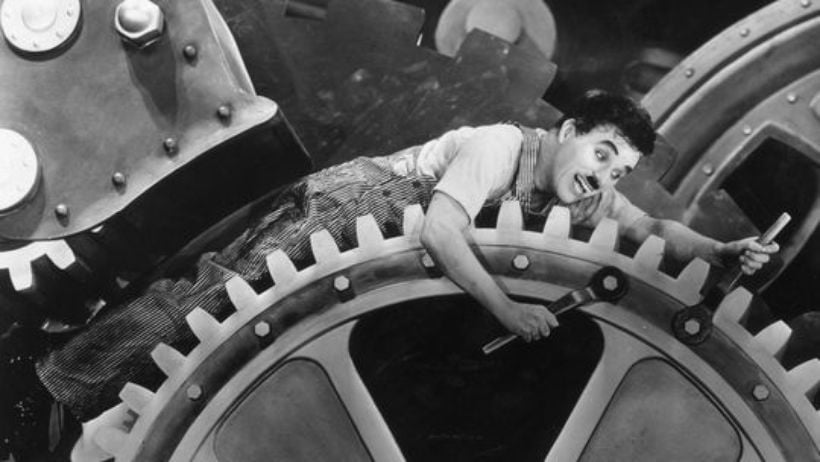We are now seventeen years into the “new millennium” – an era that great thinkers and futurists in the 20th Century imagined would be a period of prosperity and comfort for all. And yet, far from living in the technological utopia they imagined, we are increasingly living in a dystopian nightmare of eye-watering inequality and poverty amidst plenty. Hugo Robles of the Southampton Marxists looks at the contradictions of automation and machinery under capitalism.
Why hasn’t “the future” arrived yet?
Following the immense leaps and bounds in science and technology that came with the industrial revolution, and the even more impressive feats of ingenuity and discovery in the post-war years, many saw these developments as the beginning of a process of uninterrupted progress that would culminate in humans living relaxed, comfortable lives, with dazzling new inventions helping us to satisfy our every need.
Grand cities under covered roofs with moving sidewalks; journeys to space; personal robot assistants; and, more modestly, the 15-hour week: these weren’t the product of the naive imaginations of starry-eyed schoolchildren who had just read a pulp sci-fi novel – these were the predictions made by learned scientists and political thinkers. They saw the potential applications of emerging technologies. But, lacking a Marxist perspective, they did not realise the importance of the political-economic organisation of society in shaping the development and implementation of technology.
As a result, many of these technically feasible predictions rested on the assumption that these new technologies would be applied in a rational way to maximise the happiness of society in general; or that automation would – in a smooth, gradual way – reduce the amount of necessary work and, consequently, the actual need for work.
If we are to understand why these assumptions were not borne out, we have to turn to the ideas of Marxism. Marx wrote in depth about capitalism and technology; and, in particular, about automation and the question of why technological advances are not applied rationally for the benefit of all. His analysis, in short, can be summarised in one sentence: the profit motive.
Automation and the labour theory of value
Labour is a series of actions applied, by a conscious agent, to the means of production. It is the application of labour, meanwhile, that is the source of all new value. The unpaid labour of the working class – that value above and beyond what is paid back to workers in the form of wages – in turn is called surplus value. And it is from this surplus value that the capitalists obtain their profits.
Robots and machines form part of the means of production; they do not create new values, but rather represent existing value – the crystallised labour of the past – that is transferred to the new product in the process of production. Consequently, robots – and all machinery – are not capable of producing value. They merely allow humans to produce surplus value with an efficiency that was unheard of in previous centuries. This makes them incredibly attractive to capitalists as a way of increasing productivity, driving down the labour time needed to produce commodities, and thus outcompeting their rivals.
As Karl Marx wrote in his magnum opus, Capital:
“Like every other instrument for increasing the productivity of labour, machinery is intended to cheapen commodities and, by shortening the part of the working day in which the worker works for himself, to lengthen the other part, the part he gives to the capitalist for nothing. The machine is a means for producing surplus-value.”
If you – as a capitalist – can get workers to produce more in less time, but still hire them for the same wages and hours, you are going to be making a lot of profits; especially since you can just fire some of the workers outright, replacing them with machines.
But what is necessary for one capitalist – to increase profits by investing in machinery and pushing down labour costs – is also going to be necessary for all the other capitalists, causing the adoption of machinery to become generalised. This means a driving down of not just the labour time needed by individual firms to produce a given commodity, but the “socially necessary labour time” (SLNT): the average labour time required across a sector, given the general level of productivity in this industry.
The overall result is that capitalism kills the goose that lays the golden egg. As explained above, it is only the application of human labour that produces new value, and thus surplus value also. But if labour is replaced by machines, then the source of the capitalists’ profits is also removed. At the same time, it is the wages of the working class that form the market for the commodities that capitalism produces. And if workers are made unemployed by automation, then who will buy the plethora of goods being churned out?

The history of automation
In the heyday of capitalism, this process was a very progressive thing: science and technology were being developed at a rapid pace, allow things to be produced cheaply, efficiently, and uniformly, with less and less effort needed from workers.
At the same time, this progress was also contradictory, reflecting the contradictory nature of capitalism. Yes, automation eliminated the need for workers to do certain things – but only by destroying jobs in the process. Instead of reaping the benefits of higher productivity and efficiency, then, workers are fired, or threatened with being fired in order to force them into accepting a higher rate of exploitation.
This is why throughout history you see developments in machinery being accompanied by opposition, fear, anger, and sometimes even sabotage. Developments that improve the productive forces in society through automation are not developments that the workers have control over. Instead of workers reaping the benefits of these developments, then, they only benefit the capitalists – and at the workers’ expense, of course.
Automation in the 21st Century
Today, as in Marx’s day, we see how the application of automation in production follows the same logic: the logic of capital. Capitalists will not always invest in new machines, technologies, or software systems to increase productivity. This is only desirable when the investment reduces costs and increases profits; when the machinery is cheaper than the workers the machinery would replace. This, in turn, is influenced by a number of factors: the strength of the workers’ movement; the availability (supply) of workers; the cost of the new machinery itself; and so on.
Those most vulnerable to losing their jobs to automation today are not the exploited sweatshop labourers in Bangladesh, for example, but the workers in the advanced capitalist countries. Cashiers; drivers of cars, trains and buses; accountants; call centre workers; even writers, nurses and lawyers: all these professions are increasingly becoming threatened with what the bourgeois economists call “technological unemployment”. And sickeningly, the increase in technological unemployment only swells the ranks of the “reserve army of labour”, allowing workers remaining in all sectors to be exploited further, since the alternative of joblessness would be even worse.
Even though individual firms (or, rather, their owners) may benefit from losing some of their workers to technological unemployment, these individual gains disappear as this tendency becomes generalised. With fewer workers employed making more commodities, the ongoing crisis of overproduction is exacerbated. Yet from the perspective of the individual boss, this is how to remain competitive in such a crisis.
So this is what automation has to offer us under capitalism: crisis and unemployment. At least in Marx’s day this crisis and unemployment was accompanied by a general development of the productive forces in society. Today, however, this general development has stagnated. But this stagnation is not a technical problem – it is a problem born out of the archaic and anarchic social order that is capitalism.
The potential world offered to us by modern technology is one of plenty; one where everyone can have access to quality housing, food, healthcare and even luxury goods. And yet, the world ahead on the immediate horizon is a pale shadow of this possible world of abundance.
Still want that promised “future”? Fight for socialism!
When the futurists of the early 20th century and before thought of the future, they imagined the world of superabundance that socialists talk about. If history had unfolded according to their utopian visions, we would be living in that world today. But we are not – not because they were overly-optimistic about technological progress, but because they weren’t realistic about capitalism’s inability to share out the benefits of this technology.
It is not difficult to imagine a world where the vast array of society’s productive power is used for the benefit of all. We can see the enormous potential all around us. The advent of information technology makes it easier than ever to create and distribute what the capitalist leeches currently treat as their “intellectual property”. The development of 3D printing also provides tantalising hints of what modern productive technologies and techniques could achieve, making specialised and complex products available to all.
This goes to show just how much of a fetter capitalist property relations have become to progress. To remove these barriers to progress; to turn the vast array of productive forces humanity have created towards the creation of a better world for all, we must smash the rotten capitalist system itself – a system that, left unchallenged, will only continue to produce crisis and misery.
The task ahead is for the working class – the ones who actually invent these technological marvels and the ones who actually operate them – to unite, organise, and sweep the wreckage of capitalism into the dustbin of history where it belongs.






